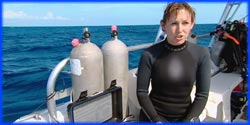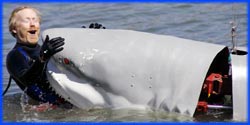


Premier Date: October 5, 2011
busted
Adam and Jamie decided to start with small-scale testing and work their way up to find any flaws. To determine the efficiency of energy transfer from ball to ball, Adam pulled the ball at one end out to a certain distance and measured the length of the swing at the other end. Their first three models—an off-the-shelf desktop toy, and two built with 2.5 and 6 in (64 and 152 mm) solid steel bearings—gave 98%, 97%, and 94% efficiency, respectively. Jamie noted that the energy loss increased at the larger scales, but did not depend directly on size or mass.
To simulate miniature wrecking balls, Adam and Jamie filled five 6 in (152 mm) hollow steel spheres with plaster that had properties similar to concrete. This version gave only 63% efficiency, but Jamie suggested putting a steel plate through the center of each ball to reduce energy transfer into the concrete. They then built five 2,000 lb (907 kg) balls by cutting hollow naval buoys in half, sandwiching a steel plate in each, and filling the space with rebar and concrete. When the rig was assembled at Mare Island Naval Shipyard and hung from an I-beam frame, it gave very poor efficiency and quickly stopped swinging, even after each ball was hung from two cables rather than one as shown in the video. Noting the increased potential for energy losses at large scales, Adam and Jamie declared the myth busted, then later learned that the original video had been faked.
busted
The Build Team set up a shipping container as a cliff, with a dirt escape ramp built up against its edge so that the test car would roll down safely if it went over the edge. Grant and Tory, in the car, eased it forward to find the balance point; after several tries and the use of a forklift and straps on the rear bumper, they were able to get the car balanced.
With Grant and Tory still in the car, various birds were brought in and allowed to perch on the hood. Two pigeons (1 lb (0.45 kg) each), two hawks (2.5 lb (1.1 kg) each), and an eagle owl (7 lb (3 kg)) were tried separately; none were able to do more than wobble the car slightly. Grant commented that although a weight near the front bumper gave a large amount of leverage, the car itself had enough weight to counteract the effect.
The team located a model helicopter and modified it to weigh 20 lb (9.1 kg), the same as a California condor (the largest flying bird in North America). When this too failed to tip the car, the team classified the myth as busted and set out to find out how much weight it would take. The car only tipped after Kari put 80 raw, 1.5 lb (0.7 kg) game hens onto the hood and Tory added a raw, 20 lb (9 kg) remote-controlled turkey for a total of 140 lb (64 kg).
(This myth was revisited in Revenge of the Myths and declared “busted” again.)
Previous: Episode 171: Bikes and Bazookas